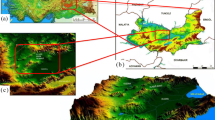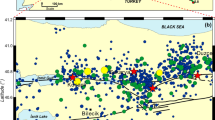Abstract
In recent years, because of a seismic gap of 136 years in the north of Chile, several studies have been carried out with the purpose of characterizing the dynamic properties of the soils of the most populated cities in this area. The purpose of this work is to estimate, by numerical modeling, the seismic amplification of a densely populated area of the city of Arica. Spatial distribution of main soil dynamic properties has been obtained from a detailed geophysical survey, including surface-wave based methods and gravimetry. To estimate the site effects, we solve the wave propagation equation in full heterogeneous media by the spectral element method. This method allows including the topography, the irregular contact between soils and bedrock and heterogeneities of main materials’ properties along the computational domain. The inelastic behavior of the soil has been considered, using stiffness degradation and damping curves. The computations were done using the high performance open-source numerical code SPEED. Results from the distribution of the peak ground acceleration are compared against standard 1D horizontally layered modeling using equivalent linear and nonlinear viscoelastic approximations of nonlinear soil behavior. Linear viscoelastic results indicate that the north area of the city of Arica is not especially prone to tridimensional site effects induced by soil’s natural variability and the apparent bedrock geometry. Nevertheless, non-conservative differences of about 20% between 1D v/s 3D analyses were found under inelastic material behavior. In general, the two 3D approaches followed to include soils’ nonlinearity provide similar site amplification estimates.










Similar content being viewed by others
References
Abraham JR, Smerzini C, Paolucci R, Lai CG (2016) Numerical study on basin-edge effects in the seismic response of the Gubbio valley, Central Italy. Bull Earthq Eng 14:1437–1459. doi:10.1007/s10518-016-9890-y
Antonietti PF, Mazzieri I, Quarteroni A, Rapetti F (2012) Non-conforming high order approximations of the elastodynamics equation. Comput Methods Appl Mech Eng 209–212:212–238. doi:10.1016/j.cma.2011.11.004
Barrientos S (2014) Informe Técnico Terremoto de Iquique. Centro Sismológico Nacional, University of Chile, Santiago (in Spanish)
Becerra A, Podestá L, Monetta R et al (2015) Seismic microzoning of Arica and Iquique, Chile. Nat Hazards 79:567–586. doi:10.1007/s11069-015-1863-y
Chávez-García Francisco J (2003) Site effects in Parkway Basin: comparision between observations and 3-D modelling. Geophys J Int 154:633–646
Chávez-García FJ, Faccioli E (2000) Complex site effects and building codes: making the leap. J Seismol 4:23–40. doi:10.1023/A:1009830201929
Chávez-García FJ, Stephenson WR, Rodríguez M (1999) Lateral propagation effects observed at Parkway, New Zealand. A case history to compare 1D versus 2D site effects. Bull Seismol Soc Am 89:718–732
Chlieh M, De Chabalier JB, Ruegg JC et al (2004) Crustal deformation and fault slip during the seismic cycle in the North Chile subduction zone, from GPS and InSAR observations. Geophys J Int 158:695–711. doi:10.1111/j.1365-246X.2004.02326.x
Comte D, Pardo M (1991) Reappraisal of great historical earthquakes in the northern Chile and southern Peru seismic gaps. Nat Hazards 4:23–44. doi:10.1007/BF00126557
Gélis C, Bonilla LF (2014) Influence of a sedimentary basin infilling description of the 2D P- SV wave propagation using linear and nonlinear constitutive models. J Int, Geophys. doi:10.1093/gji/ggu143
Hayes GP, Wald DJ, Johnson RL (2012) Slab1.0: a three-dimensional model of global subduction zone geometries. J Geophys Res 117:B01302. doi:10.1029/2011JB008524
Humire F, Sáez E, Leyton F, Yañez G (2014) Combining active and passive multi-channel analysis of surface waves to improve reliability of VS,30 estimation using standard equipment. Bull Earthq Eng. doi:10.1007/s10518-014-9662-5
Leyton F, Montalva G, Ramírez P (2012) A preliminary study of seismic microzonation of Concepción based on microtremors, geology and damages patterns. Obras y Proy 11:40–46. doi:10.4067/S0718-28132012000100004
Leyton F, Ruiz S, Sepúlveda SA et al (2013) Microtremors’ HVSR and its correlation with surface geology and damage observed after the 2010 Maule earthquake (Mw 8.8) at Talca and Curicó, Central Chile. Eng Geol 161:26–33. doi:10.1016/j.enggeo.2013.04.009
Makra KFJC-G (2016) Site effects in 3D basin using 1D and 2D models: an evaluation of the differences based on simulations of the seismic response of Euroseistest. Bull Earthq Eng 14:1177–1194. doi:10.1007/s10518-015-9862-7
Makra K, Chávez-García FJ, Raptakis D, Pitilakis K (2005) Parametric analysis of the seismic response of a 2D sedimentary valley: implications for code implementations of complex site effects. Soil Dyn Earthq Eng 25:303–315. doi:10.1016/j.soildyn.2005.02.003
Maldonado G (2014) Caracterización geológica de los suelos de fundación de la ciudad de Arica. XV región de Arica y Parinacota. Universidad Católica del Norte, Antofagasta (in Spanish)
Manakou MV, Raptakis DG, Chávez-García FJ et al (2010) 3D soil structure of the Mygdonian basin for site response analysis. Soil Dyn Earthq Eng 30:1198–1211. doi:10.1016/j.soildyn.2010.04.027
Mazzieri I, Stupazzini M, Guidotti R, Smerzini C (2013) SPEED: sPectral Elements in Elastodynamics with Discontinuous Galerkin: a non-conforming approach for 3D multi-scale problems. Int J Numer Meth Eng 95:991–1010
Nakamura Y (1989) A method for dynamic characteristics estimation of subsurface using microtremor on the ground surface. Q Rep Railw Tech Res Inst 30:25–33
Olsen K, Nigbor R, Konno T (2000) 3D Viscoelastic Wave Propagation in the Upper Borrego Valley, California, Constrained by Borehole and Surface Data. Bull Seismol Soc Am 90:134–150. doi:10.1785/0119990052
Pilz M, Parolai S, Picozzi M (2010) Shear wave velocity model of the Santiago de Chile basin derived from ambient noise measurements: a comparison of proxies for seismic site conditions and amplification. Geophys J Int 182:355–367. doi:10.1111/j.1365-246X.2010.04613.x
Régnier J, Bonilla LF, Bertrand E, Semblat JF (2014) Influence of the Vs profiles beyond 30 m depth on linear site effects: assessment from the KiK-net data. Bull Seismol Soc Am. doi:10.1785/0120140018
Schnabel PB, Lysmer J, Seed HB (1972) SHAKE—a computer program for earthquake response analysis of horizontal layered sites. Report No. EERC 71–12. Earthquake Engineering Research Center, Berkeley
Scholz CH, Campos J (2012) The seismic coupling of subduction zones revisited. J Geophys Res Solid Earth 117:1–22. doi:10.1029/2011JB009003
Seed HB, Idriss IM (1970) Soil moduli and damping factors for dynamic response analyses. Report No. EERC 70–10. Earthquake Engineering Research Center, University of California, Berkeley, California, p 40
Smerzini C (2010) The earthquake source in numerical modelinf of seismic wave propagation in heterogeneoun media. PhD Thesis, Department of Structural Engineering, Politecnico di Milano
Smerzini C, Villani M (2012) Broadband numerical simulations in complex near-field geological configurations: the case of the 2009 Mw 6.3 L’Aquila earthquake. Bull Seismol Soc Am 102:2436–2451. doi:10.1785/0120120002
Stupazzini M (2004) A spectral element approach for 3D dynamic soil-structure. PhD Thesis, Department of Structural Engineering, Politecnico di Milano
Acknowledgements
This research was partially supported by a Grant from the Chilean National Commission for Scientific and Technological Research, under FONDEF+ANDES Award Number D10I1027 and partially by the National Research Center for Integrated Natural Disaster Management CONICYT/FONDAP/15110017. The authors would like to thanks Dr. Ilario Mazzieri for his support of the use of SPEED code.
Author information
Authors and Affiliations
Corresponding author
Rights and permissions
About this article
Cite this article
Muñoz, A., Sáez, E. Numerical estimation of site effects in the city of Arica due to natural soil variability using the spectral elements method. Bull Earthquake Eng 16, 459–478 (2018). https://doi.org/10.1007/s10518-017-0214-7
Received:
Accepted:
Published:
Issue Date:
DOI: https://doi.org/10.1007/s10518-017-0214-7




